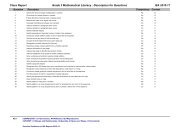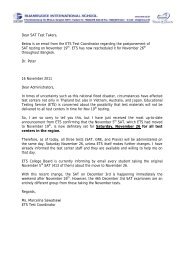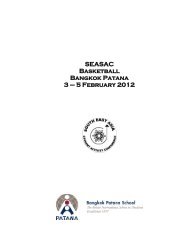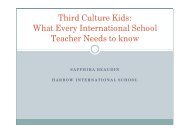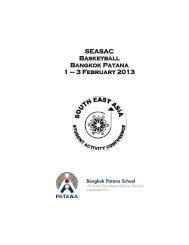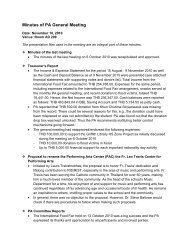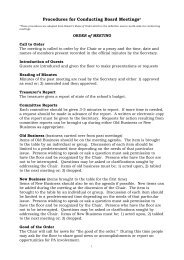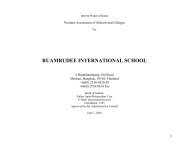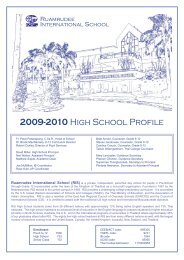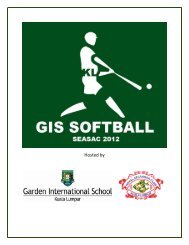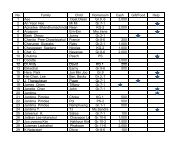Middle School Art Glossary
Middle School Art Glossary
Middle School Art Glossary
Create successful ePaper yourself
Turn your PDF publications into a flip-book with our unique Google optimized e-Paper software.
<strong>Middle</strong> <strong>School</strong> <strong>Art</strong> <strong>Glossary</strong><br />
abstract<br />
<strong>Art</strong>work in which the subject matter is stated in a brief, simplified<br />
manner; little or no attempt is made to represent images realistically,<br />
and objects are often simplified or distorted.<br />
Additive<br />
The process of joining a series of parts together to create a sculpture.<br />
Aesthetics<br />
A branch of philosophy; the study of art and theories about the nature<br />
and components of aesthetic experience.<br />
Analogous<br />
Closely related colors; a color scheme that combines several hues next<br />
to each other on the color wheel.<br />
Arbitrary<br />
colors Colors selected and used without reference to those found in the<br />
real world.<br />
<strong>Art</strong> criticism<br />
An organized system for looking at the visual arts; a process of<br />
appraising what we want students to know and be able to do.
art elements<br />
See elements of art.<br />
assemblage<br />
A three-dimensional composition in which a collection of objects is<br />
unified in a sculptural work.<br />
asymmetry<br />
A balance of parts on opposite sides of a perceived midline, giving the<br />
appearance of equal visual weight.<br />
atmospheric perspective<br />
Also called aerial perspective. Uses bluer, lighter, and duller colors for<br />
distant objects in a two-dimensional work of art.<br />
background<br />
The part of the picture plane that seems to be farthest from the<br />
viewer.<br />
balance<br />
The way in which the elements in visual arts are arranged to create a<br />
feeling of equilibrium in an artwork. The three types of balance are<br />
symmetry, asymmetry, and radial.
collage<br />
An artistic composition made of various materials (e.g., paper, cloth,<br />
or wood) glued on a surface.<br />
color<br />
The visual sensation dependent on the reflection or absorption of light<br />
from a given surface. The three characteristics of colors are hue,<br />
intensity, and value.<br />
color relationships<br />
Also called color schemes or harmonies. They to the relationships of<br />
colors on the color wheel. Basic color schemes include monochromatic,<br />
analogous, and complementary.<br />
color theory<br />
An element of art. Color has three properties: hue, value and<br />
intensity.<br />
complementary colors<br />
Colors opposite one another on the color wheel. Red/green,<br />
blue/orange, yellow/violet are complementary colors.<br />
composition<br />
The organization of elements in a work of art.
content<br />
Message, idea, or feelings expressed in a work of art.<br />
contour<br />
drawings The drawing an object as though the drawing tool is moving<br />
along all the edges and ridges of the form.<br />
contrast<br />
Differences between two or more elements (e.g., value, color, texture)<br />
in a composition; juxtaposition of dissimilar elements in a work of art.<br />
Also, the degree of difference between the lightest and darkest parts<br />
of a picture.<br />
cool colors<br />
Colors suggesting coolness: blue, green and violet.<br />
curvature<br />
The act of curving or bending; one of the characteristics of line.<br />
curvilinear<br />
Formed or enclosed by curved lines.
design<br />
The plan, conception, or organization of a work of art; the<br />
arrangement of independent parts (the elements of art) to form a<br />
coordinated whole.<br />
distortion<br />
Condition of being twisted or bent out of shape. In art, distortion is<br />
often used as an expressive technique.<br />
dominance<br />
The importance of the emphasis of one aspect in relation to all other<br />
aspects of a design.<br />
elements of art<br />
Sensory components used to create and talks about works of art: line,<br />
color, shape/form, texture, value, space.<br />
emphasis<br />
Special stress given to an element to make it stand out.<br />
expressive content<br />
Ideas that express ideas and moods.
figurative<br />
Pertaining to the human figure.<br />
foreground<br />
Part of a two-dimensional artwork that appears to be nearer the<br />
viewer or in the front. <strong>Middle</strong> ground and background are the parts of<br />
the picture that appear to be farther and farthest away.<br />
focal point<br />
The place in a work of art at which attention becomes focused because<br />
of an element emphasized in some way.<br />
form<br />
1. A three-dimensional volume or the illusion of three dimensions;<br />
related to shape (which is 2-D).<br />
2. The particular characteristics of an artworkÍs visual elements (as<br />
distinguished from its subject matter or content).<br />
function<br />
Purpose and use of a work of art.<br />
genre<br />
The representation of people, subjects, and scenes from everyday life.
gesture drawing<br />
The drawing of lines quickly and loosely to show movement in a<br />
subject.<br />
harmony<br />
The principle of design that creates unity within a work of art.<br />
hue<br />
Refers to the name of a color (e.g., red, blue, yellow, orange).<br />
installation art<br />
Refers to the hanging of ordinary objects on museum walls or the<br />
combining of found objects to create something completely new. Later,<br />
installation art was extended to include art as a concept.<br />
intensity<br />
Also called chroma or saturation. It refers to the brightness of a color<br />
(a color is full in intensity only when pure and unmixed). Color<br />
intensity can be changed by adding black, white, gray, or an opposite<br />
color on the color wheel.<br />
line<br />
A point moving in space. Line can vary in width, length, curvature,<br />
color, or direction.
line direction<br />
Horizontal, vertical, diagonal.<br />
line quality<br />
The unique character of a drawn line as it changes lightness/darkness,<br />
direction, curvature, or width.<br />
linear perspective<br />
A graphic system used by artists to create the illusion of depth and<br />
volume on a flat surface. The lines of buildings and other objects in a<br />
picture are slanted, making them appear to extend back into space.<br />
mass<br />
The outside size and bulk of a form, such as a building or a sculpture;<br />
the visual weight of an object.<br />
maquette<br />
A small preliminary model (as of a sculpture or a building).<br />
media<br />
1. Plural of medium referring to materials used to make art.<br />
2. Categories of art (e.g. painting, sculpture, film).
middle ground<br />
Area of a two-dimensional work of art between foreground and<br />
background.<br />
mixed media<br />
An artwork in which more than one type of art material is used to<br />
create the finished piece.<br />
monochromatic<br />
A color scheme involving the use of only one hue that can vary in<br />
value or intensity.<br />
mood<br />
The state of mind or feeling communicated in a work of art, frequently<br />
through color.<br />
motif<br />
A unit repeated over and over in a pattern. The repeated motif often<br />
creates a sense of rhythm.<br />
movement<br />
The principle of design that deals with the creation of action.
multimedia<br />
Computer programs that involve users in the design and organization<br />
of text, graphics, video, and sound in one presentation.<br />
negative<br />
Shapes or spaces that are or represent the areas unoccupied by<br />
objects.<br />
neutral colors<br />
Black, white, gray, and variations of brown. They are included in the<br />
color family called earth colors.<br />
nonobjective<br />
Having no recognizable object as an image. Also called<br />
nonrepresentational.<br />
observational drawing skills<br />
Drawing skills learned while observing firsthand the object, figure or<br />
place.<br />
one-point perspective<br />
A way to show 3-D objects on a 2-D surface. Lines appear to go away<br />
from the viewer meet at a single point on the horizon known as the<br />
vanishing point.
organic<br />
Refers to shapes or forms having irregular edges or to surfaces or<br />
objects resembling things existing in nature.<br />
pattern<br />
Anything repeated in a predictable combination.<br />
performance art<br />
A type of art in which events are planned and enacted before an<br />
audience for aesthetic reasons.<br />
perspective<br />
A system for representing three-dimensional objects viewed in spatial<br />
recession on a two-dimensional surface.<br />
point of view<br />
The angle from which the viewer see the objects or scene.<br />
portfolio<br />
A systematic, organized collection of student work.<br />
positive<br />
Shapes or spaces that are or represent solid objects.
printmaking<br />
The transferring of an inked image from one surface (from the plate or<br />
block) to another (usually paper).<br />
primary colors<br />
Red, yellow and blue. From these all other colors are mixed.<br />
principles of design<br />
The organization of works of art. They involve the ways in which the<br />
elements of art are arranged (balance, contrast, dominance, emphasis,<br />
movement, repetition, rhythm, subordination, variation, unity).<br />
properties of color<br />
Characteristics of colors: hue, value, intensity.<br />
proportion<br />
The size relationships of one part to the whole and of one part to<br />
another.<br />
rectilinear<br />
Formed or enclosed by straight lines.
eflection<br />
Personal and thoughtful consideration of an artwork, an aesthetic<br />
experience, or the creative process.<br />
rhythm<br />
Intentional, regular repetition of lines of shapes to achieve a specific<br />
repetitious effect or pattern.<br />
rubric<br />
A guide for judgment or scoring, a description of expectations.<br />
scale<br />
Relative size, proportion; used to determine measurements or<br />
dimensions within a design or artwork.<br />
sculpture<br />
Three-dimensional artwork that is either in the round (to be viewed<br />
from all sides) or bas relief (low relief in which figures protrude slightly<br />
from the background).<br />
secondary colors<br />
Colors that are mixtures of two primaries. Red and yellow make<br />
orange, yellow and blue make green, blue and red make violet.
shade<br />
Color with black added to it.<br />
shape<br />
A two-dimensional area or plane that may be open or closed, freeform<br />
or geometric. It can be found in nature or is made by humans.<br />
space<br />
The emptiness or area between, around, above, below, or contained<br />
within objects. Shapes and forms are defined by the space around and<br />
within them, just as spaces are defined by the shapes and forms<br />
around and within them.<br />
still life<br />
Arrangement or artwork showing a collection of inanimate objects.<br />
structure<br />
The way in which parts are arranged or put together to form a whole.<br />
style<br />
A set of characteristics of the art of a culture, a period, or school of<br />
art. It is the characteristic expression of an individual artists.
stylized<br />
Simplified; exaggerated.<br />
subordination<br />
Making an element appear to hold a secondary or lesser importance<br />
within a design or work of art.<br />
subtractive<br />
Sculpting method produced by removing or taking away from the<br />
original material (the opposite of additive).<br />
texture<br />
The surface quality of materials, either actual (tactile) or implied<br />
(visual). It is one of the elements of art.<br />
theme<br />
An idea based upon a particular subject.<br />
three-dimensional<br />
Having height, width, and depth (also referred to as 3-D).<br />
tint<br />
Color with white added to it.
tone<br />
Color with gray added to it.<br />
two-dimensional<br />
Having height and width but not depth (2-D).<br />
two-point perspective<br />
A system to show 3-D objects on a 2-D surface. The illusion of space<br />
and volume utilizes two vanishing points on the horizon line.<br />
unity<br />
A principle of design that connects a variety of elements of art and<br />
principles of design into a work of art with harmony and balance.<br />
value<br />
Lightness or darkness of a hue or neutral color. A value scale shows<br />
the range of values from black to white.<br />
value scale<br />
A value scale shows the range of values from black to white and light<br />
to dark.
vanishing point<br />
In perspective drawing a point at which receding lines seem to<br />
converge.<br />
virtual<br />
An image that is of the imagination, not of the real world.<br />
variety<br />
A principles of art concerned with combing one or more elements of<br />
art in different ways to create interest.<br />
visual literacy<br />
Includes thinking and communication. Visual thinking is the ability to<br />
transform thoughts and information into images; visual communication<br />
takes place when people are able to construct meaning from the visual<br />
image.<br />
visual metaphor<br />
Images in which characteristics of objects are likened to one another<br />
and represented as that other. They are closely related to concepts<br />
about symbolism.<br />
volume<br />
Refers to the space within a form (e.g., in architecture, volume refers<br />
to the space within a building).
warm colors<br />
Colors suggesting warmth: red, yellow and orange.<br />
watercolor<br />
Transparent pigments mixed with water. Paintings done with this<br />
medium are known as watercolors.



